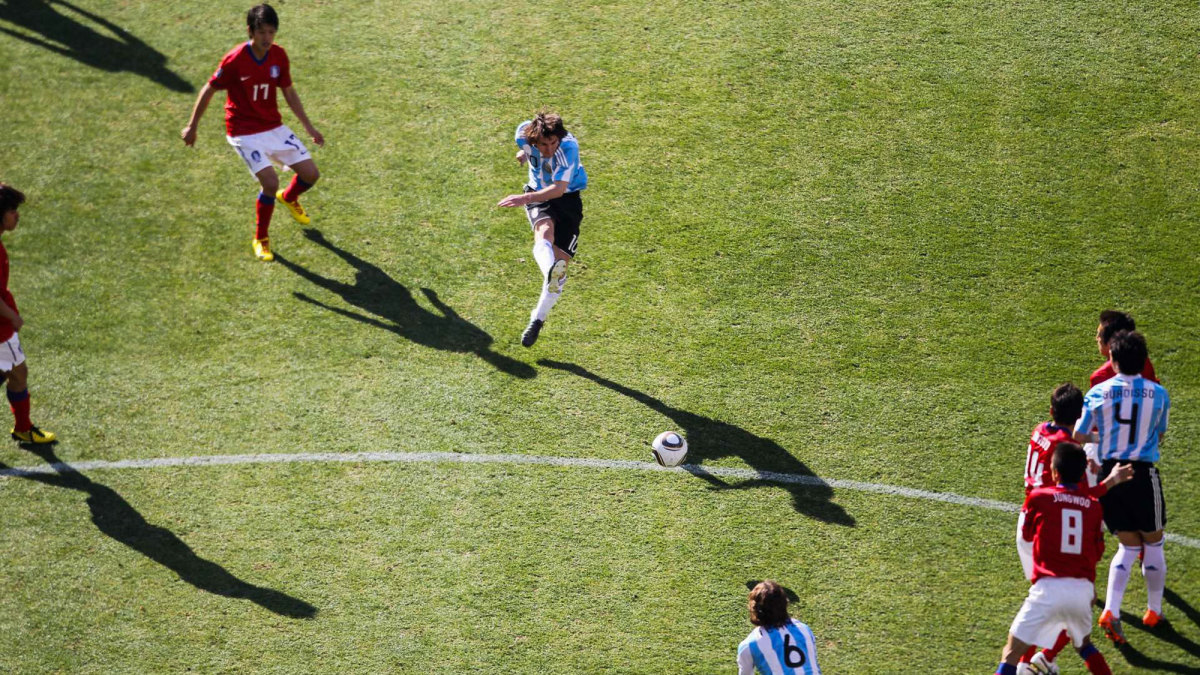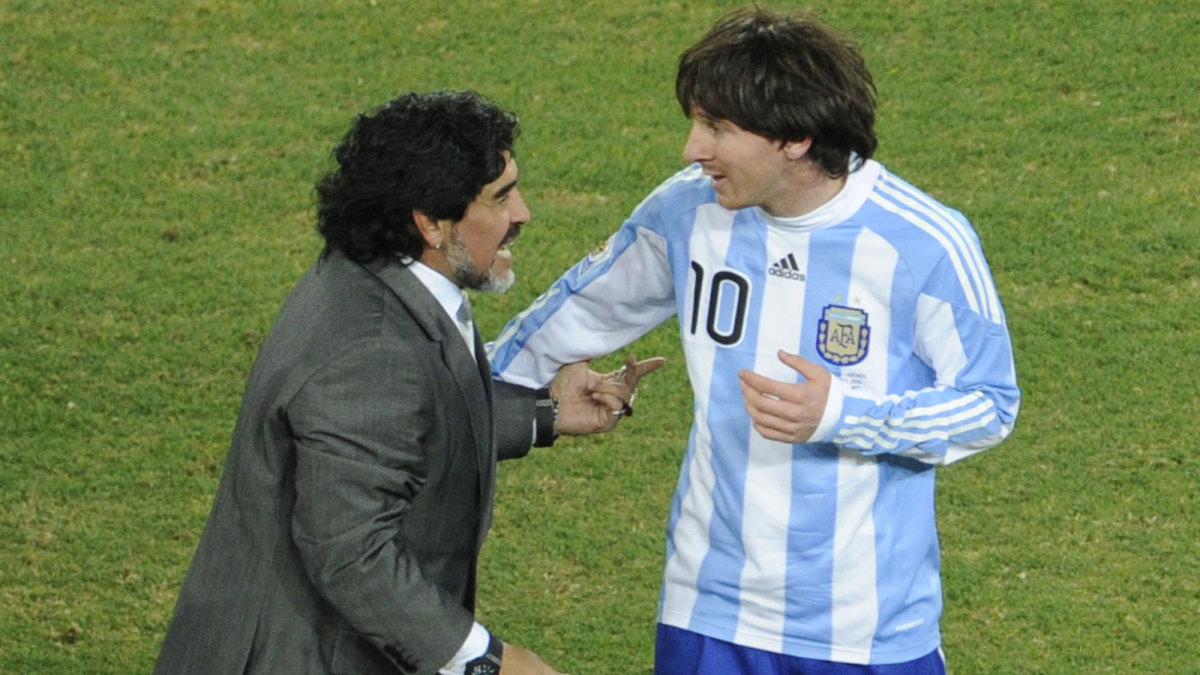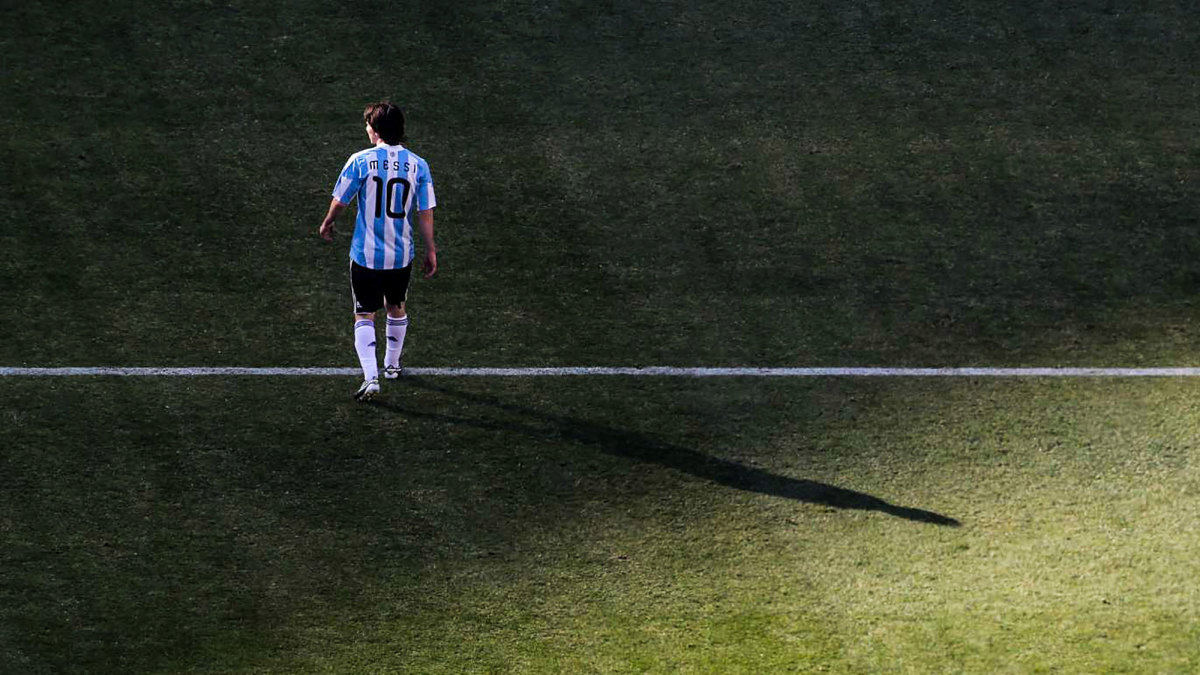Messi, Maradona and the World Cup That Set Argentina's Template for an Unfulfilling Decade
This story is part of our series looking back on the 2010 World Cup and its biggest moments and themes with a decade's worth of perspective. For more, read about the lasting legacy of the competition in South Africa, the long-tail impact of Frank Lampard's ghost goal vs. Germany, how France's debacle planted the seeds for its 2018 success and whether Luis Suarez's controversial handball was really all that evil.
Conversations about who was greater are often futile. Diego Maradona was great, and Lionel Messi is great, and whichever one you prefer–the explosive and temperamental or the relentlessly consistent–is broadly a matter of personal taste. But for Argentinians at least, what Maradona will always have that Messi as of yet does not is a World Cup title. Whatever other parameters you may set, Maradona’s performances in Mexico in 1986, particularly in the final three games, remain the greatest individual displays by anybody at a major tournament.
Three men's players–Lothar Matthaus, Rafa Marquez and Antonio Carbajal–have played in five World Cups. Messi will join them should he play for Argentina in Qatar in 2022. Maradona got four, and raged always that he had been left out as an 18-year-old in 1978. For that handful who get to five, one World Cup tends to be as an extremely inexperienced player and one as a veteran nearing the end of the road–it’s three, maximum, at their peak. Maradona, even at 22, was immature enough to be goaded into being sent off against Brazil in 1982, while by 1994 he was visibly–and, as it turned out, illegally–raging against the dying of the light.
Messi’s first World Cup came in Germany in 2006. Having missed the end of the season through injury, he made two brief substitute appearances, the second of them on his 19th birthday, and played from the start in the final group game against the Netherlands as both teams made several changes having already qualified for the knockout rounds. The idea that manager Jose Pekerman made some desperate error in not bringing him on for the fatigued Juan Roman Riquelme in the quarterfinal against Germany is an egregious example of post-hoc sermonizing: nobody knew then what Messi would become. His first World Cup as a bona fide great was in 2010.

It also paired him with Maradona, who had inexplicably been appointed as manager when Alfio Basile resigned following defeat to Chile in a qualifier in October 2008. His previous two stints as a manager had been shambolic and had yielded a total of three victories, but Argentina had a pathological faith in Maradona. Evidence and experience were irrelevant. The gastric bypass surgery, the alcohol and cocaine problems, the $37 million owed in back-taxes in Italy–none of that meant anything. He was Maradona.
His reign was predictably chaotic. There was a record-equalling 6-1 defeat in Bolivia, with Argentina’s preparation hampered by Maradona’s belief that the effects of altitude could be minimized by flying in to La Paz just a few hours before kickoff. There were defeats also to Colombia, Paraguay and Brazil, so Argentina needed to beat Peru in its penultimate qualifier to have a chance of making it to South Africa.

There was widespread disbelief when he brought back 35-year-old striker Martin Palermo, but it was the Boca Juniors target man who scuffed in a late winner amid torrential rain. In the final game in Uruguay, a late goal from Mario Bolatti completed the job. On the touchline, Maradona, swaddled in a tracksuit, a red bib flapping about him like a superhero’s cape, bounced up and down then fell over. He told the press to “suck it and keep on sucking.” Somehow, he had done it–and let nobody point out that the jeopardy was largely of his own making.
But reality bit hard in South Africa. Maradona had picked a weirdly imbalanced squad and had omitted the one right back of any quality, Javier Zanetti. Without looking especially fluent, Argentina won all three group games. It beat Mexico 3-1 in the last 16, helped on its way by a Carlos Tevez goal that was manifestly offside. But then, again, came Germany. A Thomas Muller header from a free kick put Joachim Low’s side ahead after three minutes, and what followed felt grimly inevitable.
Argentina’s collection of fine creative individuals struggled to make headway against organized opposition and, as Maradona threw on forward after forward–by the end Messi, Tevez, Gonzalo Higuain, Sergio Aguero and Javier Pastore were all on the pitch–Germany picked it off on the counterattack, winning 4-0.

Maradona’s presence made it especially shambolic, but a template was set. Three years earlier, at the Copa America in 2007, Basile’s side, after playing some extraordinary football, had lost 3-0 in the final to Brazil, but this was different. This was how it would be for the decade that followed, Argentina stuttering and spluttering, unable to find a way of unleashing its profound creative potential.
There could have been trophies along the way–defeat in extra time (Germany, again) in a World Cup final in 2014, defeat in penalty shootouts in Copa America finals in 2015 and 2016 and Higuain misses along the way that could have rewritten history–but the overwhelming feeling has been of a failure to discover a system in which Messi can thrive.
Argentina has become dependent upon his genius and, paradoxically, his genius has perhaps been inhibitive. And as each tournament has gone by, and the wait for a first trophy since 1993 has become more fraught, the dread realization has begun to dawn on Argentinians: Messi has, perhaps, two tournaments left: next summer's Copa America co-hosted by Argentina and Colombia, and the 2022 World Cup. He will be 34 in Qatar. His international career may, perhaps, end unfulfilled.
